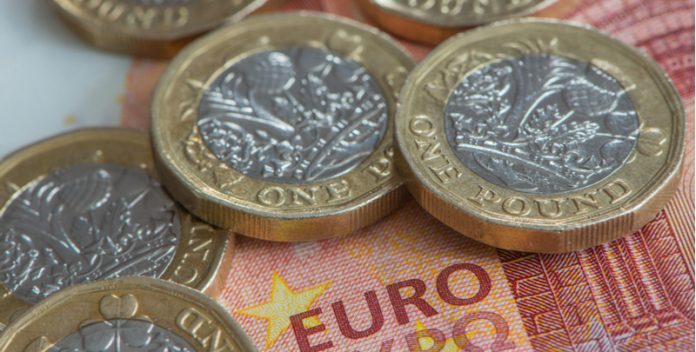Downgraded German GDP forecasts and concerns that the European Central Bank could adopt a more dovish stance sent the euro tumbling in the previous session. The pound euro exchange rate pushed higher, hitting a peak of €1. 1229 before easing back and ending the session 0.15% up at €1.1199. The pair is flat in early trade on Thursday.
| What do these figures mean? |
| When measuring the value of a pair of currencies, one set equals 1 unit and the other shows the current equivalent. As the market moves, the amount will vary from minute to minute.
For example, it could be written: 1 GBP = 1.13990 EUR Here, £1 is equivalent to approximately €1.14. This specifically measures the pound’s worth against the euro. If the euro amount increases in this pairing, it’s positive for the pound . Or, if you were looking at it the other way around: 1 EUR = 0.87271 GBP In this example, €1 is equivalent to approximately £0.87. This measures the euro’s worth versus the British pound. If the sterling number gets larger, it’s good news for the euro. |
The pound was broadly weaker in the previous session, albeit stronger than the euro. With no UK economic data to focus on investors remained glued to Brexit developments. UK Prime Minister Boris Johnson lost a Scottish court ruling on the suspension of Parliament. Rather than offering clarity, this threw the deadlocked political system into further confusion just 6 weeks ahead of the Brexit deadline. Yesterday’s result has paved the way for a showdown at the UK Supreme Court next week.
Once again, the economic data docket is empty leaving investors focused on political and Brexit developments. Even with Parliament suspended politics continue to move the pound.
German Recession Looks Unavoidable
Downgrades to the German GDP forecasts sent the euro lower in the previous session. The Kier Institute for the World Economy slashed 2019 forecasts for the Germany economic growth to just 0.4%. The institute also forecast a -0.3% contraction for the third quarter. The data reaffirms the negative outlook for the Germany economy. Whilst a technical recession, which is two consecutive quarters of contraction, hasn’t been confirmed just yet, all the signs are suggestive of one.
| Why does poor economic data drag on a country’s currency? |
| Slowing economic indicators point to a slowing economy. Weak economies have weaker currencies because institutions look to reduce investments in countries where growth prospects are low and then transfer money to countries with higher growth prospects. These institutions sell out of their investment and the local currency, thus increasing supply of the currency and pushing down the money’s worth. So, when a country or region has poor economic news, the value of the currency tends to fall. |
Attention will now turn towards the European Central Bank monetary policy announcement today. Market participants are expecting ECB President Draghi to announce a series of stimulus measures. Analysts are forecasting a 0.2% cut in the overnight deposit rate, a dovish forward guidance and an announcement regarding a new bond buying programme. This new quantitative easing programme could entail buying in the region of €30 billion euros a month.
Whilst Draghi has indicated that he is in favour of “significant and impactful” stimulus measures, there are a number of dissenting voices within the ECB. Investors have questioned whether Draghi will be able to deliver on such dovish market expectations. Should the ECB fall short of 20 basis point cut and QE announcement, the euro could move higher. A more dovish announcement, leaving the door open to further cuts could sent the euro lower.
| Why do interest rate cuts drag on a currency’s value? |
| Interest rates are key to understanding exchange rate movements. Those who have large sums of money to invest want the highest return on their investments. Lower interest rate environments tend to offer lower yields. So, if the interest rate or at least the interest rate expectation of a country is relatively lower compared to another, then foreign investors look to pull their capital out and invest elsewhere. Large corporations and investors sell out of local currency to invest elsewhere. More local currency is available as the demand of that currency declines, dragging the value lower. |
Currencylive.com is a site operated by TransferWise Inc. (“We”, “Us”), a Delaware Corporation.
The content on our site is provided for general information only. It is not intended to amount to advice on which you should rely. You must obtain professional or specialist advice before taking, or retain from, any action on the basis of the content on our site.
Although we make reasonable efforts to update the information on our site, we make no representations, warranties or guarantees, whether express or implied, that the content on our site is accurate, complete or up to date. Some of the content posted on this site has been commissioned by Us, but is the work of independent contractors. These contractors are not employees, workers, agents or partners of TransferWise and they do not hold themselves out as one. The information and content posted by these independent contractors have not been verified or approved by Us. The views expressed by these independent contractors on currencylive.com do not represent our views.





